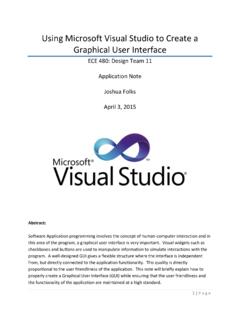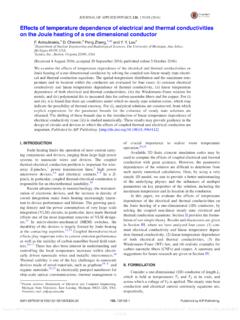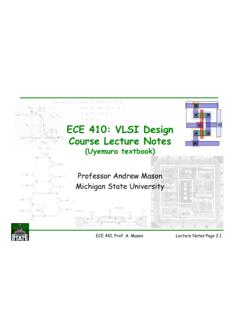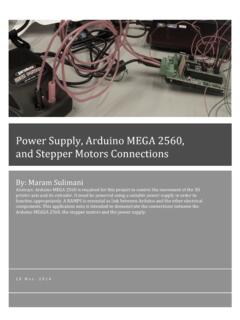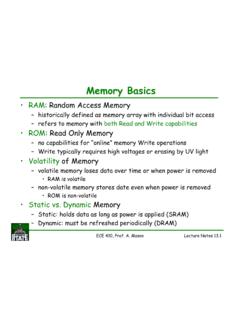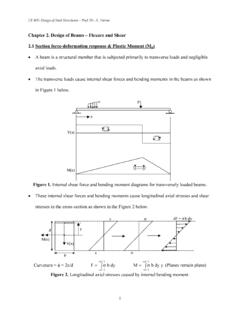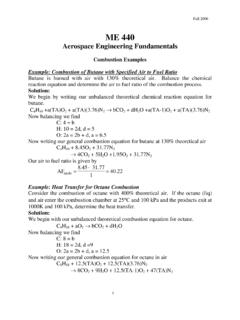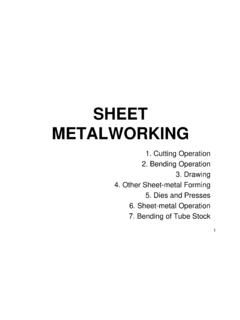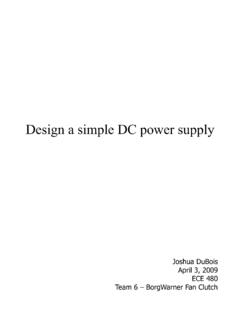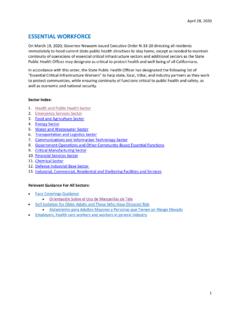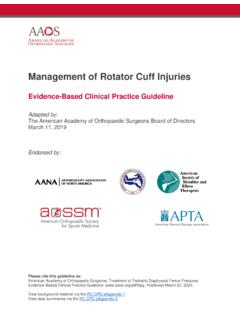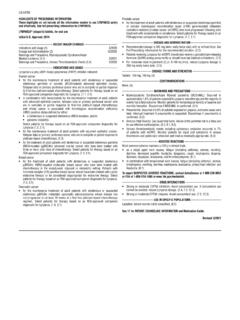Transcription of ASSEMBLY PROCESSES Welding FUNDAMENTALS OF WELDING
1 ME477 Fall 2004. 1. Overview PART VII JOINING &. WELDING A joining process of two materials that ASSEMBLY PROCESSES coalesced at their contacting (faying) surfaces by the application of pressure and/or heat. FUNDAMENTALS OF WELDING Weldment The assemblage Joining - WELDING , brazing, soldering, and adhesive bonding Sometime a filler material to facilitate coalescence. to form a permanent joint between parts Advantage: portable, permanent, stronger than the ASSEMBLY - mechanical methods (usually) of fastening parts together parent materials with a filler metal, the most Some of these methods allow for easy disassembly. economical method to join in terms of material usage and fabrication costs . 1. Overview of WELDING Technology Disadvantage: Expensive manual Labor, high 2. The Weld Joints energy and dangerous, does not allow disassemble 3. Physics of WELDING and defects 4. Features of a Fusion Welded Joint 1 2. Two Types of WELDING WELDING Operation Fusion WELDING melting base metals 50 types PROCESSES (American WELDING Society).
2 Arc WELDING (AW) heating with electric arc Applications: Constructions, Piping, pressure vessels, Resistance WELDING (RW) heating with resistance to boilers and storage tanks, Shipbuilding, Aerospace, an electrical current Automobile and Railroad Oxyfuel WELDING (OFW) heating with a mixture of Welder - manually controls placement of WELDING gun oxygen and acetylene (oxyfuel gas) Fitter assists by arranging the parts prior to WELDING Other fusion WELDING electron beam WELDING and WELDING is inherently dangerous to human workers laser beam WELDING High temperatures of molten metals, Solid State WELDING No melting, No fillers Fire hazard fuels in gas WELDING , Diffusion WELDING (DFW) solid-state fusion at an Electrical shock in electric WELDING elevated temperature Ultraviolet radiation emitted in arc WELDING (a special helmet with a dark viewing window) and Friction WELDING (FRW) heating by friction Sparks, spatters of molten metal, smoke, and fumes (good Ultrasonic WELDING (USW) moderate pressure with ventilation).
3 Ultrasonic oscillating motion Automation - Machine, Automatic and Robotic WELDING 3 4. 2. The Weld Joint 3. Physics of WELDING Types of Joints Coalescing Mechanism: Fusion via high-density energy Butt joint Process plan to determine the rate at which WELDING can be performed, the size of the region and power density Corner joint for fusion WELDING P. Lap joint Powder density (PD): PD =. Tee joint A. Edge joint where P = power entering the surface, W (Btu/sec); and Types of Welds A = the surface area, mm2 (in2). With too low power density, no melting due to the heat conducted into Fillet weld work Groove weld With too high power density, metal vaporizes in affected regions Must find a practical range of values for heat density. Plug and slot welds In reality, pre & post-heating and nonuniform Spot and Seam welds For metallurgical reason, less energy and high heat Flange and Surfacing welds density are desired. 5 6. Kwon 1.
4 ME477 Fall 2004. Approximate Power Densities and Physics of WELDING II. Efficiency The estimated quantity of heat: U m = KTm2 where K= WELDING process W/mm2 (Btu/sec-in2). Heat waste: Oxyfuel 10 (6). Heat transfer efficiency, f1, between heat source and surface Arc 50 (30). Heat problem: Oxyfuel gas WELDING is inefficient while Arc WELDING is relatively efficient. Resistance 1,000 (600). Melting efficiency, f2 , due to the conduction of a work material Laser beam 9,000 (5,000). Conduction problem: Al and Cu have low f2 Electron beam 10,000 (6,000). Net Heat Available for WELDING : H w = f1 f 2 H. Balance between energy input and energy for WELDING : Arc WELDING Process f1. H w = U mV Shield Metal Arc WELDING Rate Balance: HR = U WVR Gas Metal Arc WELDING w m = f1 f 2 HR = U m AwV Flux-cored Arc WELDING Submerged Arc WELDING where WVR=volume rate of metal welded 7 Gas Tungsten Arc WELDING 8. 4. Features of Fusion Welded Joint Weld Fusion zone Interface UBMZ HAZ.
5 A typical fusion weld joint consists of fusion zone, weld interface, heat affected zone and unaffected base metal zone. WELDING PROCESSES . Fusion zone: a mixture of filler metal and base metal melted together homogeneously due to convection as in Fusion WELDING Heat & melting casting. Epitaxial grain growth (casting) Arc WELDING Weld interface a narrow boundary immediately Resistance WELDING solidified after melting. Oxyfuel WELDING Heat Affected Zone (HAZ) below melting but Other Fusion WELDING substantial microstructural change even though the Solid-state WELDING Heat and pressure, but same chemical composition as base metal (heat no melting & no filler treating) usually degradation in mechanical properties Weld Quality Unaffected base metal zone (UBMZ) high residual Weldability stress Design Consideration 9 10. 1. Arc WELDING (AW) AW with Consumable Electrodes A fusion WELDING where the Shielded Metal Arc WELDING (SMAW).
6 Coalescence of the metals A consumable electrode a filler metal rod (base metals and filler) is coated with chemicals for flux and shielding (230-460mm long and in achieved by the heat from diameter). electric arc. The filler metal must be comparable with base metals. Productivity: Arc time Current: 30-300A and Voltage: 15-45V. Technical issues Arc WELDING Process f1 Cheaper and portable than oxyfuel WELDING Less efficient and variation in current due to Electrodes consumable and non- Shield Metal Arc WELDING the change in length of consumable consumable electrodes electrodes during the process. Gas Metal Arc WELDING Arc Shielding To shield the arc Gas Metal Arc WELDING (GMAW). Flux-cored Arc WELDING from the surrounding gas. Helium Use a bare consumable electrode and argon are typically used. Flux Submerged Arc WELDING Flooding the arc with a gas which depends does a similar function. on the metal Gas Tungsten Arc WELDING No slag build-up and higher deposition rate Power source dc for all metals or ac for typically steels H w = f1 f 2 H = U mV than SMAW.
7 Metal Inert Gas (MIG) or CO2 WELDING where f1 is the heat efficiency Heat loss due to convection, f 2 is the melting efficiency conduction and radiation H is the total heat generated 11 12. V is the metal volume melted Kwon 2. ME477 Fall 2004. AW with Consumable Electrodes AW with non-consumable Electrodes Flux-cored Arc WELDING (FCAW). Use a continuous consumable tube Gas Tungsten Arc WELDING (GTAW). with flux and others such as deoxidizer Tungsten (Wolfram) Inert Gas (TIG) WELDING and alloying elements With or without a filler metal Two types Tungsten melts at 3410 C. Self-shielded flux has an ingredient for Shielding gas: argon, helium or a mixture shielding All metals (commonly Al and Stainless steels). Gas-shielded external gas in a wide range of thickness Produce high quality weld joint Slow and costly but high quality weld for thin Electrogas WELDING (EGW) sections Flux-cored or bare electrode with plasma Arc WELDING (PAW) a special form external shield gas and water-cooled of GTAW but with a constricted plasma gas to molding shoes.
8 Attain a higher temperature Used in shipbuilding Carbon Arc WELDING Graphite is used as Submerged Arc WELDING (SAW) electrode Shielding is provided by the granular Stud WELDING for cookware, heat radiation flux fin. Large structures 13 14. 2. Resistance WELDING Force Spot WELDING Cycle RW heat and pressure to + electrode accomplish coalescence. Weld nugget Power source: heat generated: H = I 2 Rt Resistance WELDING PROCESSES - electrode Resistance spot WELDING (RSW). Electrodes Cu-based or Force refractory(Cu+W). Rocker-arm spot welders (1) (2) (3) (4) (5). Resistance seam WELDING (RSEW). Resistance projection WELDING (RPW). Force, Current Flash WELDING (FW) Heating by Force resistance Current Upset WELDING similar to FW but pressed during heating and upsetting. Percussion WELDING similar to FW but shorter duration (1) (2) (3) (4) (5) time High-frequency (induction and resistance). WELDING 15 16. 3. Oxyfueld gas WELDING 4.
9 Other Fusion WELDING Oxyfuel gas weldings (OFW) Use Electroslag WELDING similar to electrogas WELDING , no arc is various fuels mixed with oxygen used Thermit (from Thermite ) WELDING , dated 1900, is a fusion . Oxyacetylene WELDING A mixture of WELDING process that uses a mixture of Al powder and iron acetylene and oxygen oxide in 1:3 ratio for exothermic reaction (reaching 2500 C). Total heat: 55x106J/m3 Used in railroad, repair cracks in ingot and large frame and shaft. Acetylene: odorless but commercial acetylene has a garlic order. Unstable at 1atm thus dissolved in acetone. Other gases MAPP (Dow), Hydrogen, Propylene, Propane and Natural gas Outer Envelope (1260 C). Acetylene feather Inner cone (2090 C). 17 18. (3480 C). Kwon 3. ME477 Fall 2004. High Energy beam WELDING 5. Solid-State WELDING No filler metals but w/o local melting with either Electron Beam WELDING pressure-alone or heat and pressure. A high-velocity, narrow-beam electron converting into heat to Intimate contact is necessary by a through cleaning produce a fusion weld in a vacuum (Multiple degrees of vacuum) or other means.
10 From foil to plate as thick as 150mm Solid-state WELDING PROCESSES Very small heat effected zone Forge WELDING Samurai sword f EI. Power density PD = A 1. Cold WELDING high pressure Laser Beam WELDING Roll WELDING A high-power laser beam as the source of heat to produce a fusion Hot-pressure WELDING weld without a filler material Diffusion WELDING at Due to the high density energy on a small focused area, narrow and Explosive WELDING mechanical locking commonly used to deep penetration capability bond two dissimilar metals, in particular to clad one metal Pulsed beam for spot-weld thin samples on top of a base metal over large areas Continuous beam for deep weld and thick sample Friction WELDING friction to heat : Gillette Sensor razor Ultrasonic WELDING oscillatory shear stresses of ultrasonic 19 20. Explosive, Friction & Ultrasonic WELDING Comparison 21 22. 6. Weld Quality Residual Stress and Distortion WELDING fixtures, Heat sink,Tack WELDING , control weld condition, Preheating, Stress-relief heat treatment, Proper design WELDING Defects Cracks, Cavities, Solid Inclusions, Incomplete Fusion Imperfect shape, Miscellaneous Defects such as arc strike and excessive spatter.
